Insights
The state of tech and SaaS communications: Improving UX with every message

Insights

The right user experience (UX) is vital to software and technology companies that want to keep their customers. But the user experience goes beyond the interface, features, and workflows. It extends to every email, mobile message, and in-app notification you deliver.
The way you communicate with users is an irreplaceable part of UX. Whether it’s an automated message or a personalized promotion, each touchpoint reflects your brand and your product. In some cases, it even makes sense to call customer communications part of the product.
Do your messages to users support them and promote growth? Does your communication strategy help you provide a seamless experience that your users want and expect? Results from our survey on customer communications will shed some light on whether you’re hitting the mark.
New research from Sinch provides insights into how different types of digital communication impact the overall customer experience. The research also explores emerging solutions that support and enhance user communications.
In early 2025, Sinch conducted a global survey of 2,800 consumers to find out more about their preferences, expectations, and frustrations around the messages they receive from brands. We also surveyed over 400 business leaders in technology and software as a service (SaaS).
You’ll find big-picture results in our report, The state of customer communications. However, since there were so many interesting findings, we needed a closer look. That’s why we’re taking a deeper dive with an industry specific report for leaders in the technology space.
Let’s find out what hundreds of decision-makers in the tech industry have to say about their approach to communicating with users.
The foundation of a tech communication strategy includes choosing the best channels to use for different situations throughout the user journey.
Because preferences vary, and certain channels lend themselves to specific types of communication, it was no surprise to see that tech organizations rely on a diverse set of channels:
use the traditional channel of email for user communication.
use SMS/text messaging to communicate with users.
use the voice channel (phone calls/call center) in their communication strategy.
rely on in-app messages for communications that are built into the software.
have implemented AI-driven chatbots to automate certain user communications.
are using mobile messaging apps such as WhatsApp and Messenger.
Because some communication channels get crowded and ignored, it can make sense to use less-common options, like WhatsApp, when you’ve got messages that need to break through the noise. If email performance and engagement are a struggle, for example, increasing use of mobile messaging may help.
With so many options for technology communications, and even more reasons to connect with users, strategies can quickly get complicated. So, what are the biggest challenges and roadblocks tech respondents say they’re facing in 2025?
When we asked leaders in healthcare, FinServ, and retail to identify all the challenges they experience, three rose to the top of the list: security, cost, and integration. This trio was consistently in the top three.
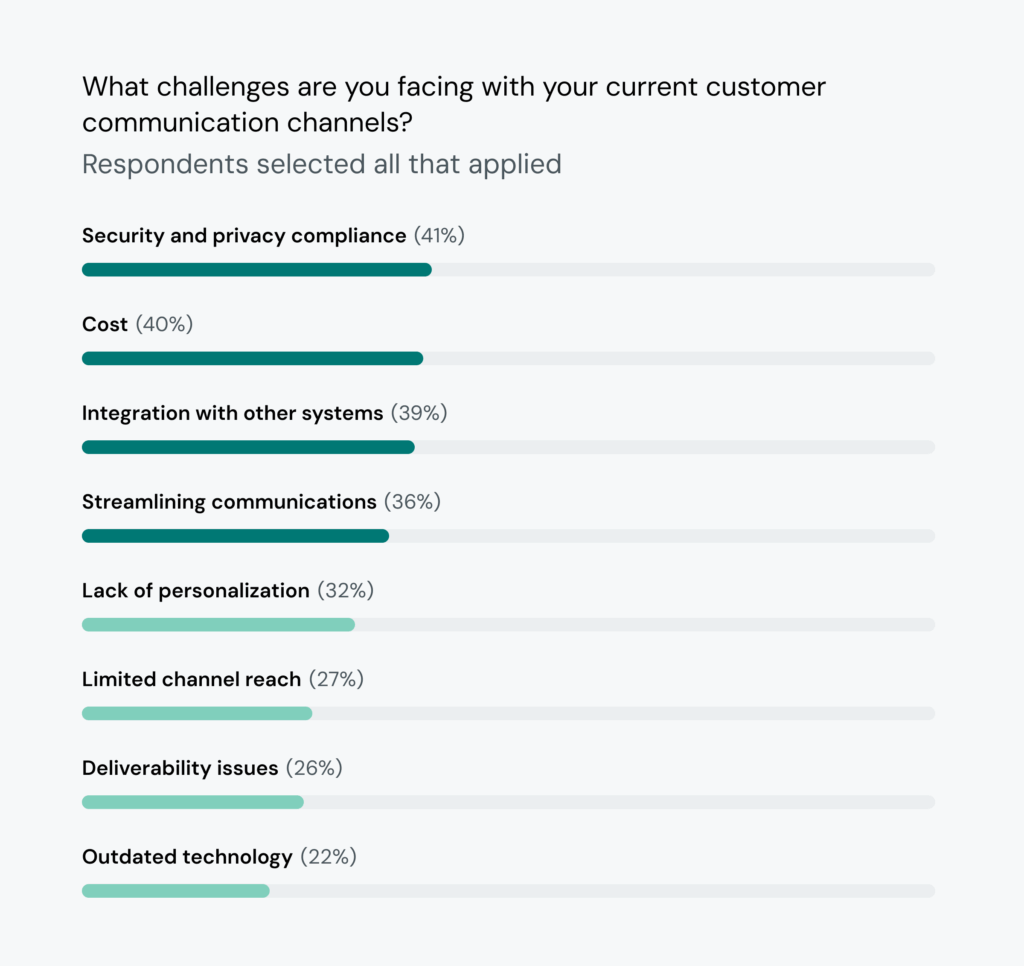
Around 40% of technology respondents identified at least one of these key challenges as something causing problems in their organizations. But security and privacy compliance (41%) nudged out cost and integration for the top spot.
The tech/SaaS industry may understand the security risks associated with digital communications more than others. Because tech products and services are inherently digital, technology companies have plenty of experience fighting off bad actors. That includes high industry awareness of tactics like phishing, smishing, and brand spoofing that trick people and potentially expose sensitive information.
A cybersecurity breach can also mean a failure to comply with privacy laws that protect your users. That’s top of mind when decision-makers are choosing user communication solutions.
A combined 85% of tech respondents said they are somewhat or very concerned about data security and regulatory compliance (GDPR, CCPA, etc.) when selecting or implementing communication channels.
Integration of customer communication can happen in a few different ways:
Compared to other industries Sinch surveyed, tech companies tended to have higher levels of channel integration. Around 71% said key channels are fully connected to support the user experience and 62% said comms are fully integrated with their tech stack.
However, that still leaves around one-third of tech business leaders who say communications are only partially or minimally integrated. For those organizations, and even for those who are “fully integrated,” improving integration with existing systems is an ongoing project.
Despite more than half of tech respondents claiming to be fully integrated with existing systems, 50% call improving integration with the tech stack a strategic priority this year.
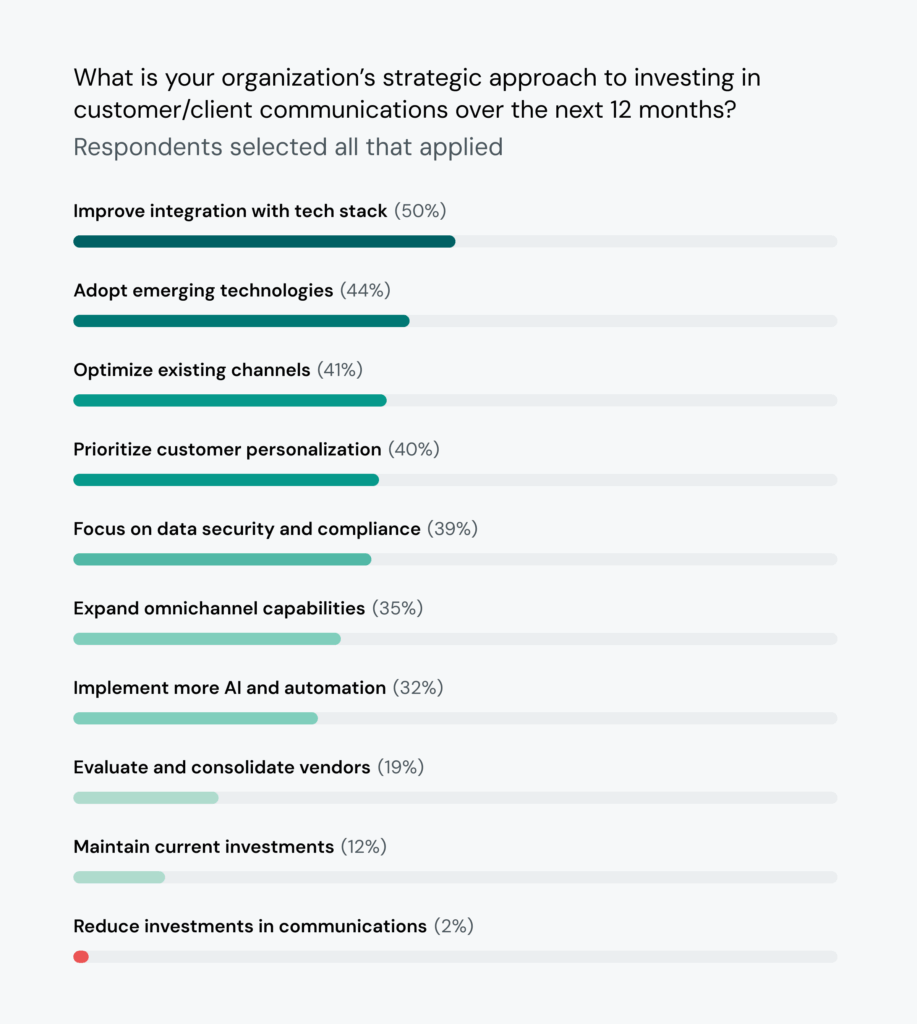
After integration, many technology companies and SaaS brands plan to look for ways to innovate over the next year. 44% say they plan to make strategic investments by adopting emerging communication technology. Another 41% want to optimize existing channels.
Let’s take a closer look at where they plan to make those investments.
Technology companies are innovators and early adopters by nature. These brands are often on the cutting-edge of what’s breaking new ground in their industry and across the globe.
Sinch’s research suggests tech leaders are setting their sights on using artificial intelligence in new and exciting ways. Around two-thirds (66%) say they plan to invest in AI voice bots over the next 12 months. All told, 95% of tech organizations expect to invest in emerging communication channels in some way this year.
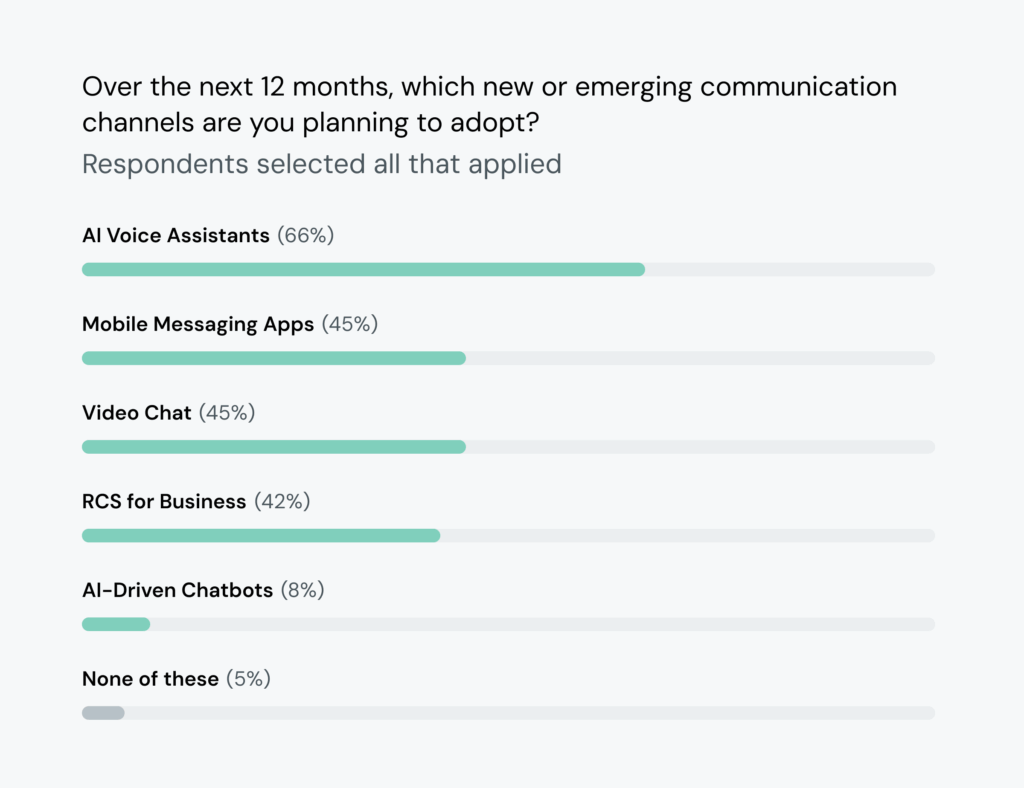
At the bottom of the list, only 8% of technology respondents plan to invest in AI chatbots. That stands in stark contrast to other industries’ plans. More than 55% of healthcare, retail, and FinServ respondents said they would adopt AI chatbots this year.
But remember, 53% of tech respondents report they are already using AI chatbots for user communication. Sinch’s Head of AI thinks many tech companies are moving on from basic chatbots and exploring more advanced ways to use artificial intelligence in digital communications.
“AI is already widespread in the tech industry. Companies are implementing a range of AI systems, such as multi-modal AI, predictive AI, recommender systems, and AI agents – where AI agents may not be labeled as chatbots by them, even though their functionality is often quite similar.”

Let’s take a closer look at how artificial intelligence is being utilized. When we asked tech leaders to choose all the ways they currently use or plan to implement AI, only 1% said they had no plans to do so. That means 99% of tech companies are using AI in customer communications.
The most common ways the tech industry uses for AI in our survey were analysis of customer data (59%) and predictive communications (46%). Both these examples represent ways to use AI to provide a better, personalized, more relevant user experience.
Data analysis helps you understand your users, and predictive communication helps you anticipate their needs.
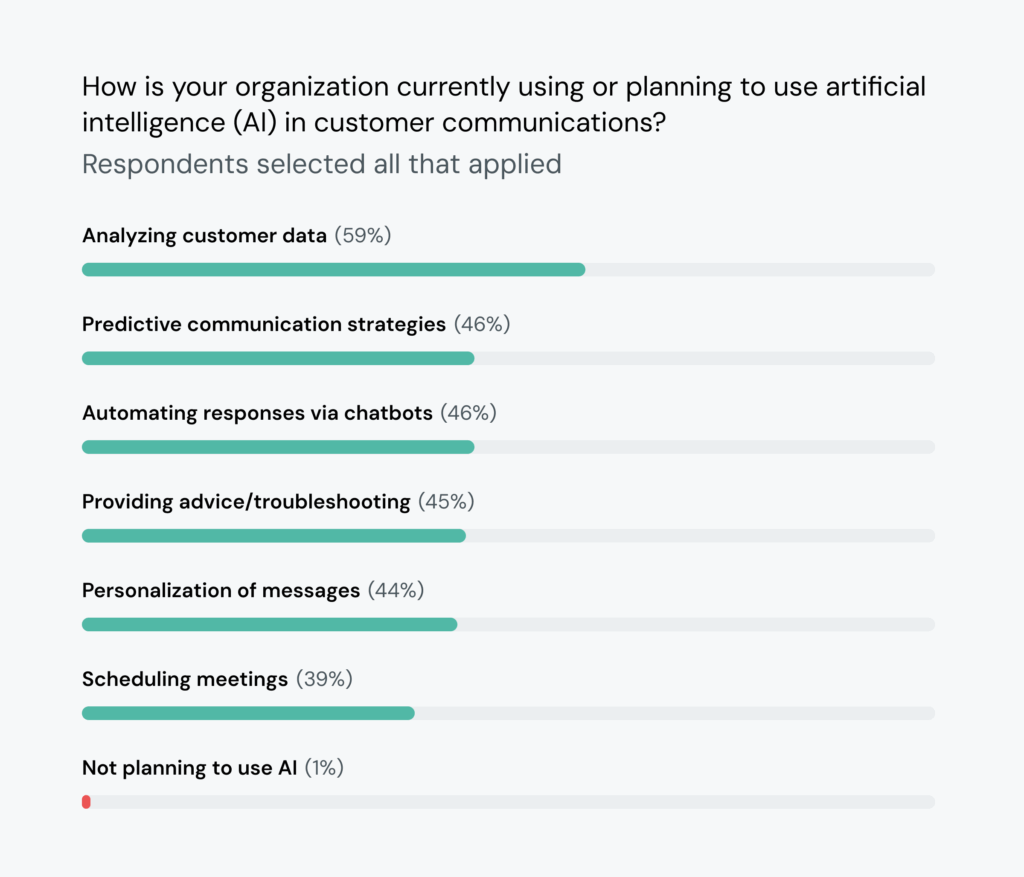
Advancements in AI are happening quickly. Organizations across industries are racing to find ways to use it in ways that improve efficiency, productivity, speed-to-market, and more. Despite that sense of urgency, it’s worth taking a pause to think about how AI can truly improve user experiences and to consider the potential risks of AI in communications.
When Sinch asked business respondents what concerns them most about using AI in customer communications, results showed the technology industry is noticeably less concerned about issues like customer trust, data security, and regulatory compliance. Check out the full report on The state of tech communications to learn more.
However, tech respondents seem a bit more concerned about the impact of AI on the workplace than their counterparts in other industries. Perhaps that is because some technology leaders have an even better understanding of AI’s capabilities and potential for disruption.
While retail and healthcare respondents seem more concerned with a “loss of human touch” from AI implementation, tech survey results show greater concern around employee displacement and the ethical use of AI.
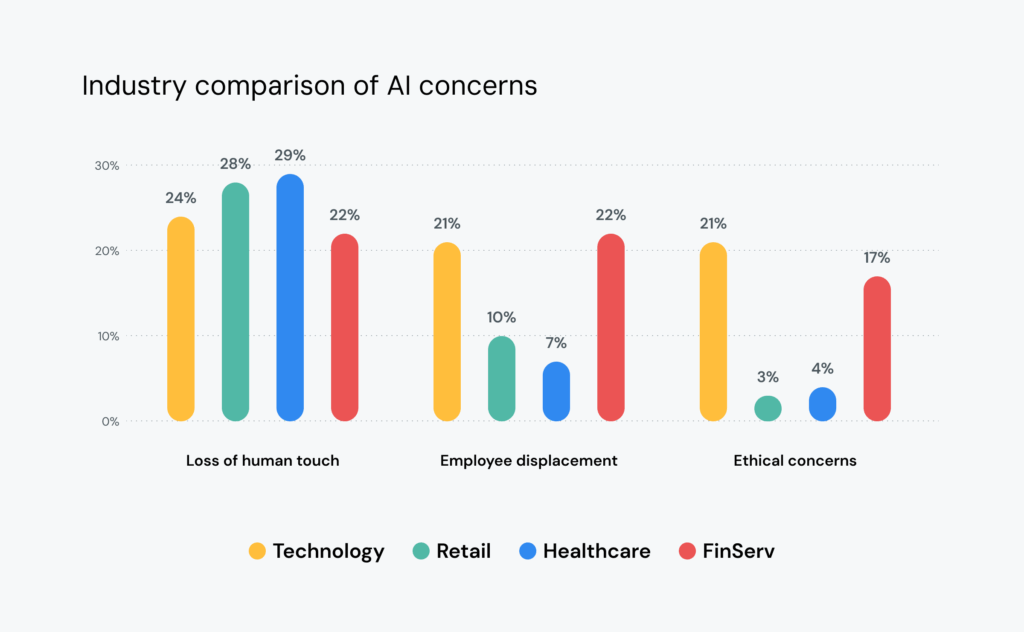
Even though these factors were near the bottom of the list of AI concerns, the results show at least 1 out of 5 tech leaders worries about issues like employee displacement and the ethics of AI.
Artificial intelligence offers many opportunities. Still, the wisest brands will think carefully about when and how they roll out AI powered communication features, rather than simply introducing and promoting AI features in a futile attempt to keep up with the fast pace of change. At the same time, no one can deny that plenty of change is on the way.
Rich Communication Services (RCS) messages aren’t exactly new. But this messaging protocol is definitely poised to transform the kinds of experiences you can deliver to mobile devices.
RCS for Business brings the engaging functionality of an app-like experience to the native messaging application on users’ smartphones. That means everything from multimedia, buttons, and suggested replies to interactive maps, branded messages, and analytics.
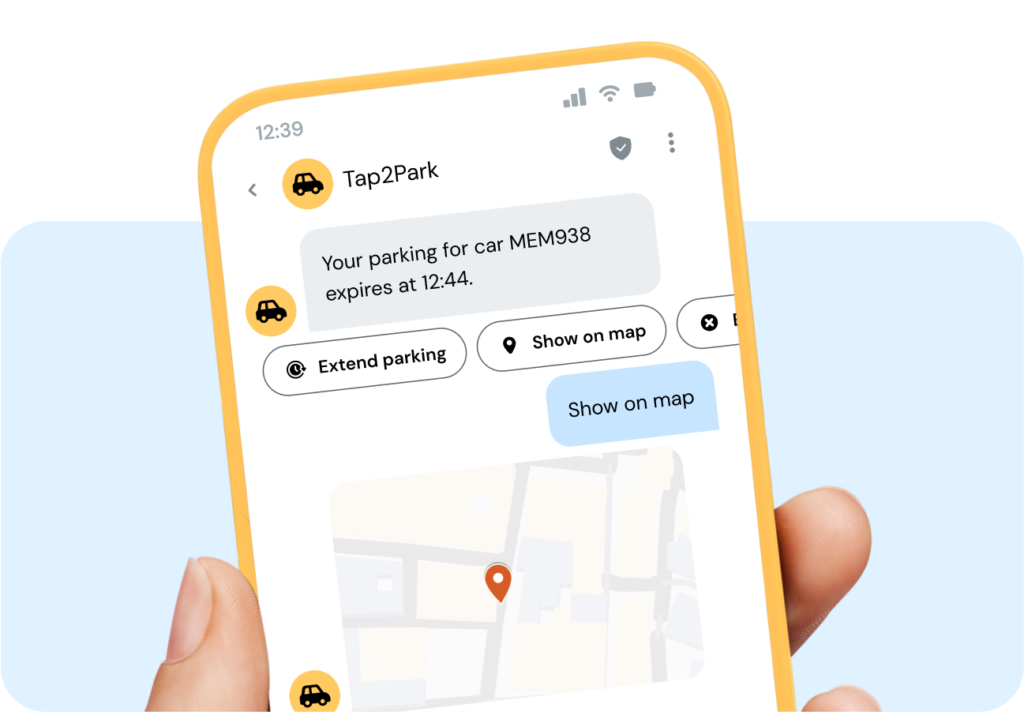
Sinch found that around 85% of technology survey participants were at least somewhat familiar with RCS and its capabilities. However, among those who are already familiar, 71% of tech respondents believe RCS for Business will be game-changing for customer communication.
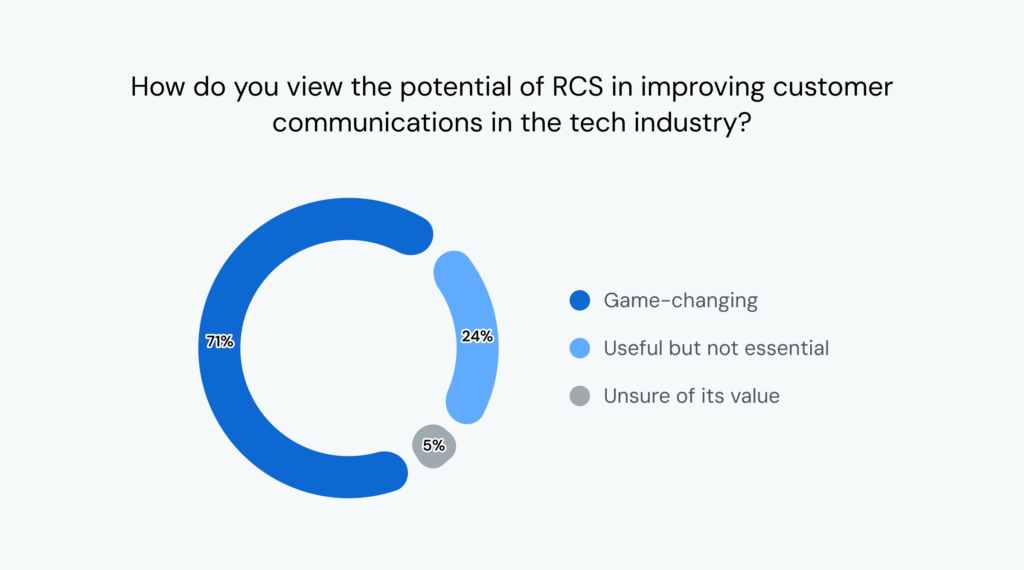
There are a lot of reasons to be optimistic about the advantages RCS offers in terms of better digital customer communications. Here’s what tech respondents call the biggest advantages of RCS messaging:
say RCS will help improve security in customer communication.
believe RCS will help them deliver better personalized experiences.
say RCS messages will help boost customer engagement.
think RCS will be a cost-effective communication solution.
Sinch’s research also found that nearly 40% of technology companies claim they are already using RCS for Business in their customer communications mix. And when we asked consumers to review RCS vs SMS and MMS, the richer RCS experience was always preferred by more people.
In addition to the 400+ technology leaders Sinch surveyed, our reports also feature results from a survey of more than 2,800 global consumers.
While we realize that many tech and SaaS companies are B2B and not B2C, much of the consumer research can still be applied. Namely, it offers insights into big-picture preferences around digital communications.
That includes best practices for keeping your users engaged, informed, safe, and happy. Those four factors are what Sinch calls the “pillars of customer communication.”
Let’s look at some of the top takeaways related to these four pillars of digital customer communication and how they relate to tech companies.
Engaging communications delivered to tech users could include automated lifecycle marketing messages. These are often designed to drive product adoption and encourage potential upsells.
Technology companies also deliver promotions to a mass audience of both current users and prospects. When it comes to channel preference for promotional messages, many people prefer email.
77% of consumer survey respondents chose email as one of three channels they prefer when receiving marketing messages. Text messaging and other mobile messaging apps (WhatsApp, Messenger, etc.) followed in second and third place.
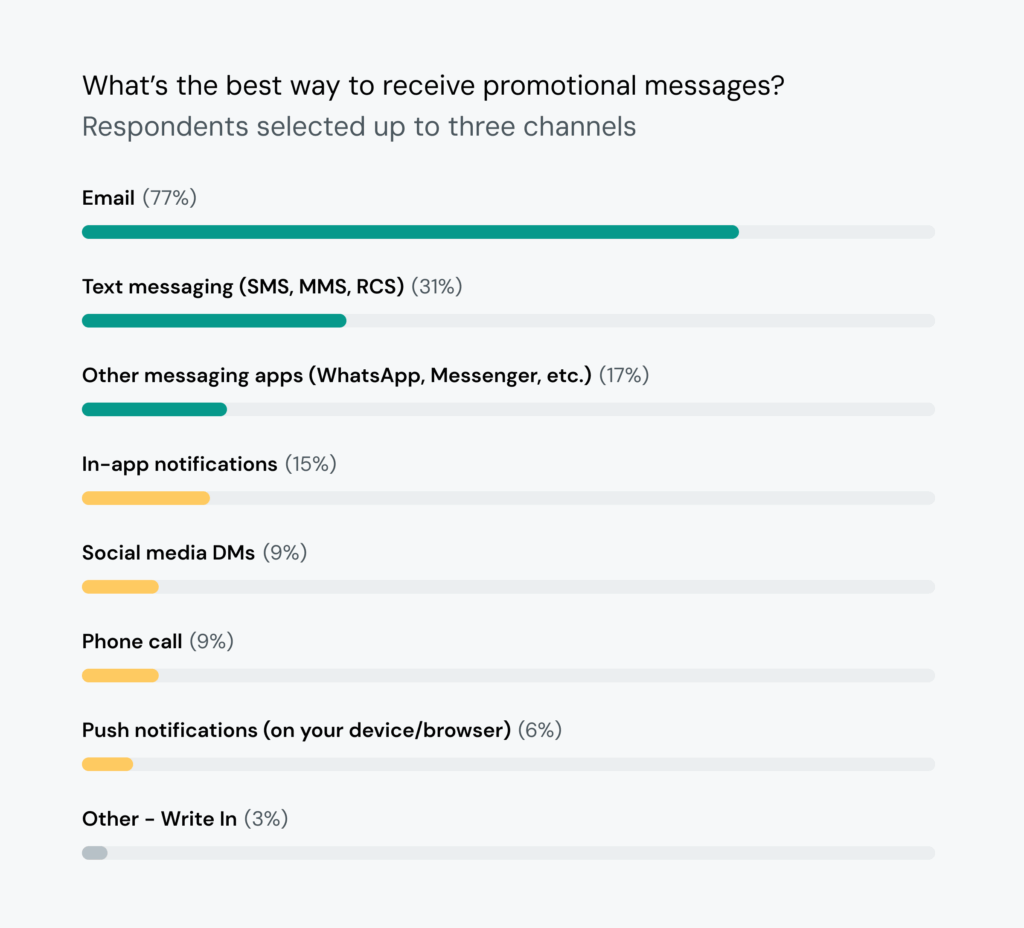
The email inbox is a common place for marketing messages. Mailbox providers, like Gmail, even offer a separate Promotions tab to keep all those campaigns organized. Consumers want and expect to get promotions via email. But inboxes are cluttered.
RCS for Business and messaging apps like WhatsApp could be an excellent addition to email marketing efforts. RCS and WhatsApp both allow for well-designed, branded, interactive campaigns. That includes features like sending videos, which isn’t possible with email.
Consider using RCS and WhatsApp if you want your tech marketing to break through the noise. Get more information on RCS capabilities in Sinch’s RCS hub.
Plus, check out our guide on how to use WhatsApp marketing for your business.
Mass marketing messages may be more likely to annoy customers and prospects than important informational communications. However, Sinch’s research shows there’s still a risk of frustrating users with informational updates, including transactional messages.
Here’s what is most likely to bother people about informative communications:
when messages are too frequent or excessive.
when messages are redundant or repetitive.
when they are unable to ask questions or get support.
when messages don’t arrive in time (too early or too late).
Keeping users informed is critical. But it’s possible to over-inform and under-inform people. Customers who feel messages are excessive or redundant aren’t having an ideal experience. Notifications and updates usually get more opens/reads than marketing messages. That’s because they’re often very relevant to the recipient. But if engagement on these messages is going down, you may want to rethink the frequency and timing of sends.
When customers have billing questions or need information about a product update, you can provide them with two-way messaging for conversational experiences. Or you can use the voice channel and have people reach out by phone.
Poorly timed customer updates will ruin the user experience. For example, a billing reminder that arrives after you’ve already paid is frustrating and wasteful. But notifications that fail to arrive on time or reach the recipient at all can be even worse. That’s why deliverability is so important.
A somewhat unsettling finding from Sinch’s research was that many consumers (35%) think email is the communication channel that is least likely to be used for phishing and brand spoofing. Of course, the opposite is true.
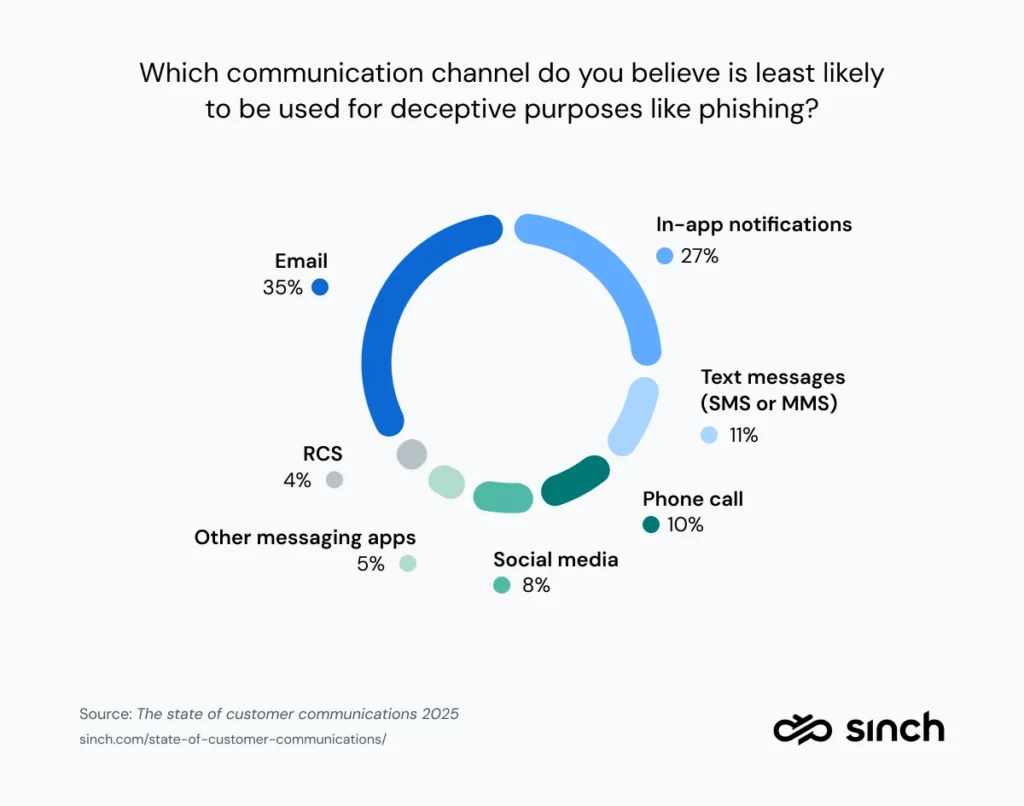
Email is a popular playground for bad actors and considered one of the biggest threat vectors. However, senders can do more to stop phishing when they enforce a DMARC policy, which is an email specification that helps authenticate messages sent from your domain.
While only 4% of consumers thought RCS was unlikely to be used for phishing – RCS for Business messages come with visual identifiers that prove communications came from a recognizable, trustworthy brand.
Sinch research found the presence of an official logo and/or a checkmark or badge makes 79% of people more likely to trust a message is safe. Your brands name, logo, and a check/badge are visible on every RCS message. That’s because any brand using RCS for Business must become a verified sender first.
The truth is – bad actors have increasingly sophisticated tactics that are likely to trick your users at some point. That’s why account verifications messages, such as one-time passwords and multi-factor authentication (MFA), are an indispensable first line of defense.
Another innovative option for account verification is Sinch Flash Call®, which uses missed calls to authenticate users and could help reduce messaging costs.
Happy users come out of a satisfactory experience with your tech products and services. One of the most impactful aspects of that experience involves interactions people have with customer support and customer success teams. These conversations can dictate how happy (or frustrated) users are with your brand.
Here are some key findings on customer support that relate to the technology industry:
of people regularly reach out for technical support, which was the most popular option.
of people regularly turn to customer support for trustworthy advice.
Solid technical support is a must-have for nearly every tech company. And it certainly helps if you have experts on hand to deliver trustworthy advice that helps with troubleshooting and getting the most of your product.
Many times, these support interactions take place on multiple channels. To support a cohesive, efficient experience, it’s best if information flows between channels. This means users won’t be forced to repeat information or re-explain the problem. Information first given to a chatbot, for example, carries over to a phone call, text, or email.
59% of consumers say it’s important that information provided to support transfers between communication channels. A combined 66% of consumers feel frustrated or that their time is wasted when forced to repeat themselves to support. Another 15% say doing so makes them lose trust in the brand.
Companies across industries are turning to AI to help them automate customer support. There are many benefits to adopting AI-driven customer support solutions. That includes the fact that chatbots are always available and can answer people immediately.
Our survey found more than half of technology respondents (53%) already use AI chatbots for customer communication. 46% say they are or plan to use AI to automate responses to customers.
But how do everyday consumers feel about using AI chatbots? Sinch’s research found 42% of people are comfortable using a chatbot trained on a company’s support documentation. That leaves 32% who say they wouldn’t use such a chatbot while 26% are unsure.
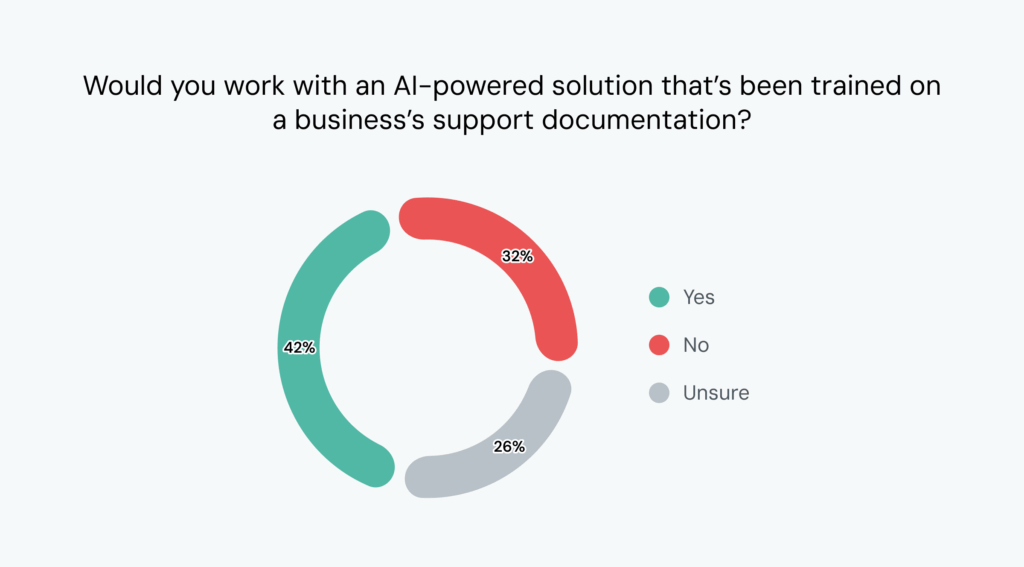
It’s quite likely some of the people who did not answer “Yes” to this question have already used AI chatbots from businesses. If not, they’ve likely used voice bot solutions like Amazon Alexa, Apple’s Siri, or Google Assistant without giving it much thought.
New technology can seem scary to some people, and it tends to bring out the skeptics. But sentiments around AI are evolving almost as fast as the technology itself.
What’s interesting is that younger generations seem much more open to AI chatbots. 72% of Gen Z respondents and 58% of millennials say they’re willing to work with bots that’ve been trained to provide support.
Think of these younger users as the early adopters. It won’t be long before the majority of consumers have similar levels of comfort with AI chatbots. That is – as long as brands build bots that enhance the user experience.
If there’s one thing the tech and SaaS space should take from this research, it’s this: Great communication is great UX. And there’s always room to improve both.
While integration and security remain top concerns, tech companies also stand out as early adopters of game-changing communication solutions. That’s a major strength. But staying ahead means going further: connecting every message, channel, and system to create seamless, secure, and responsive experiences.
At Sinch, we help technology teams do exactly that. Whether you’re scaling support, improving in-app messaging, or safeguarding users with trusted verification, our flexible messaging APIs as well as easy-to-use applications help you build bulletproof communications into the product and the user journey.